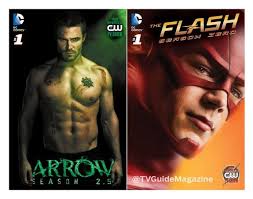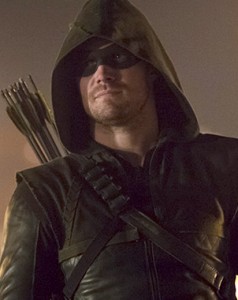The CW

CWTV – Superhero Fight Club
In this club, there are no rules. Watch this fan exclusive and get ready for the final episodes of The Flash and Arrow, beginning Tuesday and Wednesday at 8/7c!
 The CW Television Network (most commonly referred to as The CW) is an American broadcast television network that is operated by The CW Network, LLC, a limited liability joint venture between CBS Corporation, the former owners of the United Paramount Network (UPN), and the Warner Bros. Entertainment subsidiary of Time Warner, former majority owner of The WB Television Network. The “CW” name is derived from the first letters of the names of these corporations (CBS and Warner Bros.). The CW is sometimes referred to as the “Green Network”, in reference to the company’s green logo.
The CW Television Network (most commonly referred to as The CW) is an American broadcast television network that is operated by The CW Network, LLC, a limited liability joint venture between CBS Corporation, the former owners of the United Paramount Network (UPN), and the Warner Bros. Entertainment subsidiary of Time Warner, former majority owner of The WB Television Network. The “CW” name is derived from the first letters of the names of these corporations (CBS and Warner Bros.). The CW is sometimes referred to as the “Green Network”, in reference to the company’s green logo.
The network made its debut on September 18, 2006, after its two predecessors, UPN and The WB, respectively ceased independent operations on September 15 and September 17 of that year. The CW’s first two nights of programming – on September 18 and 19, 2006 – consisted of reruns and launch-related specials. The CW marked its formal launch date on September 20, 2006, with a two-hour season premiere of America’s Next Top Model. The network’s programming lineup is intended to appeal to people ranging in age from 18 to 34-years-old. The network currently runs programming six days a week: airing Monday through Fridays in the afternoon and in primetime, along with a Saturday morning live-action educational programming block produced by Litton Entertainment called One Magnificent Morning.
The CW is also available in Canada on cable, satellite and IPTV providers through stations owned-and-operated by CBS Corporation and affiliates that are located within proximity to the Canada–United States border (whose broadcasts of CW shows are subject to simultaneous substitution laws imposed by the Canadian Radio-television and Telecommunications Commission, if a Canadian network holds the broadcast rights), and through three affiliates owned by Tribune Media that are classified in that country as superstations – New York City affiliate WPIX, Los Angeles affiliate KTLA and Chicago affiliate WGN-TV.
The CW is also available in Mexico through affiliates located near the Mexico–United States border (such as XETV-TDT/Tijuana-San Diego) on pay television providers. In both countries, some CW affiliates are receivable over-the-air in border areas depending on the station’s signal coverage.
History – Origins – The WB and UPN
 The CW’s original pre-launch logo. At the network’s first upfront presentation on May 18, 2006, the provisional blue-and-white rectangle logo that was used during the network’s formation announcement in January was replaced by a green-and-white, curved-letter insignia that drew comparisons to the logo used by CNN, another company with Time Warner ownership interest.
The CW’s original pre-launch logo. At the network’s first upfront presentation on May 18, 2006, the provisional blue-and-white rectangle logo that was used during the network’s formation announcement in January was replaced by a green-and-white, curved-letter insignia that drew comparisons to the logo used by CNN, another company with Time Warner ownership interest.
The CW Television Network is a successor to The WB and the United Paramount Network (UPN), both of which launched within one week of each other in January 1995. However, both networks can be seen as descendants of the Prime Time Entertainment Network (PTEN), which launched in September 1993 as a joint venture between Warner Bros. Entertainment and Chris-Craft Industries. The two companies later became partners in The WB and UPN (UPN in conjunction with Viacom, The WB in a joint venture with the Tribune Company), with PTEN continuing in operation as a separate syndication service until it folded in 1997.
Both UPN and The WB networks began just as the Fox network had started to secure a foothold with American television audiences. Both launched to limited fanfare and generally mediocre to poor results. However, over the subsequent 11½ seasons, both networks were able to air several series that became quite popular (such as Buffy the Vampire Slayer, Star Trek: Voyager, 7th Heaven, Dawson’s Creek and Charmed). Towards the end of their first decade on the air, The WB and UPN were in decline, unable to reach the audience or have the effect that Fox had gained within its first decade, much less than that of the Big Three networks (ABC, CBS and NBC). In the eleven years that UPN and The WB were on the air, the two networks lost a combined $2 billion. Incidentally, Chris-Craft Indisturies, Viacom and Time Warner officials had discussed a possible merger of UPN and The WB as early as September 1995, only nine months after their respective launches; however discussions ultimately broke down over issues on how to combine Chris-Craft and Tribune Broadcasting’s station interests in the proposed merged network, since the two companies’ station portfolios overlapped with one another in several major markets.
Rather than facing questionable futures as separate networks, executives from CBS and Time Warner announced on January 24, 2006, that they would respectively shut down both networks and combine resources to form a new broadcast network, to be known as The CW Television Network, that would – at the outset – feature programming from both of its predecessors-to-be, as well as new content developed specifically for the new network. CBS chairman Les Moonves explained that the name of the new network was formed from the first letters of CBS and Warner Bros, joking, “We couldn’t call it the WC for obvious reasons.” Although some executives reportedly disliked the new name, Moonves stated in March 2006[8] that there was “zero chance” the name would change, citing research claiming 48% of the target demographic were already aware of the CW name.
In May 2006, The CW announced that it would pick up thirteen programs from its two predecessors to air as part of the network’s inaugural fall schedule: seven series held over from The WB (7th Heaven, Beauty and the Geek, Gilmore Girls, One Tree Hill, Reba, Smallville and Supernatural) and six held over from UPN (America’s Next Top Model, Veronica Mars, Everybody Hates Chris, Girlfriends, All of Us and WWE SmackDown). Upon the network’s launch, The CW chose to use the scheduling model utilized by The WB due in part to the fact that it had a larger total of weekly programming hours than UPN (The WB carried 30 hours of programming each week due to it having a children’s program block and a daytime lineup that UPN did not offer; UPN was primarily a primetime-only network with 12 weekly hours of network programming at the time of the network’s shutdown).
2006–2011: Beginnings
 Like both UPN and The WB, The CW targets its programming towards younger audiences. CBS and Time Warner hoped that combining their networks’ schedules and affiliate lineups would strengthen The CW into a fifth “major” broadcast network. One week before the network’s official launch, on September 11, 2006, a new, full version of the network website, www.cwtv.com, was launched; the website began to feature more in-depth information about The CW’s shows.
Like both UPN and The WB, The CW targets its programming towards younger audiences. CBS and Time Warner hoped that combining their networks’ schedules and affiliate lineups would strengthen The CW into a fifth “major” broadcast network. One week before the network’s official launch, on September 11, 2006, a new, full version of the network website, www.cwtv.com, was launched; the website began to feature more in-depth information about The CW’s shows.
The CW launched with a premiere special/launch party from the CBS-produced Entertainment Tonight at Warner Bros. Studios in Burbank, California on September 18, 2006, after a repeat of the 10th season finale of 7th Heaven; the same schedule was repeated on September 19, 2006 with the sixth season finale of Gilmore Girls airing in the second hour of primetime. The network continued to air season finales from the previous season through the remainder of the first week, except for America’s Next Top Model and WWE SmackDown, which respectively began their new seasons on September 20 and September 22, with two-hour premieres. When Top Model made its network premiere on September 20, 2006, The CW scored a 3.4 rating/5 share (with hourly ratings of 3.1/5 and 3.6/6; The CW placed fifth overall) in the Nielsen household ratings. It scored a 2.6 rating among Adults 18–49, finishing fourth in that age demographic and beating the 2.2 rating earned by Fox that night. The network’s second week consisted of season and series premieres for all of its other series from September 25 to October 1, with the exception of Veronica Mars, which debuted its third season on October 3.
On May 9, 2008, The CW announced it would lease its Sunday lineup (5:00–10:00 p.m. Eastern and Pacific Time) to production company Media Rights Capital (MRC). As Sundays had historically been a low-rated night for the network during its first two seasons on the air, the move allowed The CW to concentrate on its Monday through Friday primetime schedule, while giving MRC the right to develop and schedule programs of its own choosing and reap advertising revenue generated by the lineup. The Sunday series that were scheduled – two reality series (4Real and In Harm’s Way) and two scripted series (Valentine and Easy Money) – performed poorly in the ratings (averaging only 1.04 million viewers[13]), prompting The CW to scrap its agreement with MRC and program Sunday nights on its own starting on November 30, 2008 – with no backup first-run programming available to run on Sundays, the network added reruns of The Drew Carey Show and Jericho, and movies to replace the MRC-produced programs.
 One of the shows carried over to the network from UPN, WWE Friday Night SmackDown, ended its run on The CW after the September 26, 2008 episode due to negotiations ending between the WWE and The CW on renewing the program. Representatives for The CW later confirmed that it had chosen not to continue carrying SmackDown because the network had redefined its target audience as exclusively females 18- to 34-years-old, whereas Smackdown targeted a predominately male audience – although it continued to air some shows that targeted male viewers such as Smallville and Supernatural. Following Smackdown ’s move to MyNetworkTV that same season, the Fox-owned network (which launched the same month as The CW’s debut, albeit two weeks earlier, on September 5, 2006) began beating The CW in the Friday ratings every week from that program’s debut on the network, though The CW continued to beat MyNetworkTV overall. SmackDown would eventually leave broadcast television altogether in October 2010, when the program moved to the Syfy cable channel.
One of the shows carried over to the network from UPN, WWE Friday Night SmackDown, ended its run on The CW after the September 26, 2008 episode due to negotiations ending between the WWE and The CW on renewing the program. Representatives for The CW later confirmed that it had chosen not to continue carrying SmackDown because the network had redefined its target audience as exclusively females 18- to 34-years-old, whereas Smackdown targeted a predominately male audience – although it continued to air some shows that targeted male viewers such as Smallville and Supernatural. Following Smackdown ’s move to MyNetworkTV that same season, the Fox-owned network (which launched the same month as The CW’s debut, albeit two weeks earlier, on September 5, 2006) began beating The CW in the Friday ratings every week from that program’s debut on the network, though The CW continued to beat MyNetworkTV overall. SmackDown would eventually leave broadcast television altogether in October 2010, when the program moved to the Syfy cable channel.
The CW has generally struggled in the Nielsen ratings since its inception, primarily placing fifth in all statistics tabulated by Nielsen (total audience viewership and demographic ratings). On several occasions, The CW has even been outrated by Spanish language network Univision. This had led to speculation within the industry (including a May 16, 2008 article in The Wall Street Journal that CBS, Time Warner or both companies could abandon the venture if ratings did not improve. However, The CW’s fortunes were buoyed in the 2008–09 and 2009–10 television seasons thanks to increased ratings among females in the 18–34 demographic and the buzz that some of its newer series (such as Gossip Girl, 90210 and The Vampire Diaries) had generated with audiences. Executives with CBS Corporation and Time Warner also emphasized their commitment to the network.
On May 5, 2009, The CW announced that it would give the five hours of network time on Sundays back to its affiliated stations that fall, effectively becoming a weeknight-only network in primetime, in addition to The CW Daytime and The CW4Kids blocks (the latter block, airing on Saturday mornings, would remain the only weekend programming supplied by the network). This, in turn, discontinued the Sunday late afternoon repeat block that The CW inherited from The WB (formerly branded by that network as “EasyView”) through its use of the predecessor network’s scheduling model. Subsequently in mid-May, 65% of The CW’s affiliates, including those carrying The CW Plus, signed agreements to continue to air the replacement MGM Showcase movie package on Sundays, which was offered as a traditional syndicated film package meant for The CW’s former Sunday primetime slot.
2011: New Leadership
In 2011, Mark Pedowitz succeeded original president of entertainment Dawn Ostroff; Pedowitz assumed broader responsibilities in The CW’s business operations than Ostroff had, as the network’s first president. As president of entertainment, Ostroff oversaw entertainment operations while John Maatta, the network’s chief operating officer, handled business affairs; both reported to a board composed of CBS and Warner Bros. executives. Maatta began reporting to Pedowitz as a result of the latter’s appointment as network president. Pedowitz revealed that the core target demographic of the network would not change, though The CW would attempt to lure new viewers. Pedowitz began looking to bring comedies back to The CW after former president, Dawn Ostroff, publicly declared that the difficulty of developing comedies for its target demographic as the reason for their removal from the network following the 2008–09 season (with Everybody Hates Chris, and The Game – a spin-off of Girlfriends – becoming the last comedies to be cancelled). The network also ordered more episodes of its original series and ran them consecutively through the first week of December, starting on September 12, without repeats.
In October 2011, the network entered into digital distribution deals with streaming services Netflix and Hulu. The Netflix deal is a four-year agreement that allows its customers to instantly watch more than 700 hours of previous seasons of The CW’s current scripted series, while Hulu inked a five-year deal, giving the streaming site access to next-day content from four of the five major networks (with the exception of CW sister network CBS). In 2012, Pedowitz no longer referred to the target demographic of The CW as women 18-34, but rather as an “18-34 adult network.”
2012–present: Breakthrough
 After struggling since its inception, The CW began to experience success with the introduction of action-superhero series Arrow (based on DC Comics’ Green Arrow franchise), which received favorable reviews from critics and became a hit with audiences when it premiered in September 2012. As evidence of the network’s refocusing toward a more inclusive audience, Arrow not only premiered to the highest overall viewership in the network’s history (being watched by four million viewers), it also gave the network its strongest performance in the demographic of males 18-34 since Smallville ended its run in May 2011. Around this time, the network introduced an image campaign under the “TV Now” slogan, in part to emphasize the availability of CW content across television, computer and mobile platforms.
After struggling since its inception, The CW began to experience success with the introduction of action-superhero series Arrow (based on DC Comics’ Green Arrow franchise), which received favorable reviews from critics and became a hit with audiences when it premiered in September 2012. As evidence of the network’s refocusing toward a more inclusive audience, Arrow not only premiered to the highest overall viewership in the network’s history (being watched by four million viewers), it also gave the network its strongest performance in the demographic of males 18-34 since Smallville ended its run in May 2011. Around this time, the network introduced an image campaign under the “TV Now” slogan, in part to emphasize the availability of CW content across television, computer and mobile platforms.
On October 24, 2012, The CW entered into its first video-on-demand distribution deal with a pay television provider through an agreement with Comcast that allows customers to watch the four most-recent episodes of the network’s primetime shows on the cable provider’s Xfinity On Demand service, along with next-day episode content. The CW On Demand, which is accessible to subscribers at no additional charge, debuted on Comcast Xfinity systems nationwide on October 25. On November 21, 2013, The CW beat NBC for the first time in the key demographic of Adults 18-49 for a single calendar night.
On April 28, 2014, CBS and The CW announced that they would begin coordinating advertising sales together. The two networks will continue to set pricing for commercials independently of one another, but the sales teams will coordinate and share resources in research and other areas to develop strategies that bring value to advertising. Rob Tuck, executive vice president of sales for The CW, will continue to report to Mark Pedowitz, but with added direction from CBS’ president of sales, Jo Ann Ross.
On October 14, 2014, The CW announced that John Maatta would step down as its executive vice president. Maatta is the longest serving executive of The CW, having transitioned from his post as Chief Operating Officer at The WB; Maatta also holds the distinction of being the first employee hired by The WB, after that network’s founder Jamie Kellner. Company-wide cutbacks at Time Warner resulted in the Warner Bros. Entertainment division instituting several layoffs and the elimination of executive positions at The CW in November 2014. One of these positions belonged to senior vice president of alternative programming Kristin Connolly Vadas, one of two alternative programming executives at The CW, who was in charge of the network’s unscripted projects since 2008. Vadas had been working alongside Justin Rosenblatt, who will remain The CW’s sole alternative programming executive.
 Buoyed by Arrow ’s success, The CW continued to build momentum in subsequent seasons. The network finally found success with its summer programming in 2013, with the revival of the U.S. version of the improv comedy series Whose Line Is It Anyway?, which later became part of the network’s fall-to-spring schedule; this was subsequently followed in 2014 by the strong performance of midseason sci-fi drama The 100. The 2014–15 season saw the premieres of two critically acclaimed shows that also earned strong ratings: Arrow spin-off The Flash and freshman comedy-drama Jane the Virgin (loosely adapted from the Venezuelan telenovela Juana la Virgen). The Flash surpassed Arrow as the highest-rated program in the network’s history; while Jane the Virgin earned some of the highest critical praise of any 2014–15 series, and during its first season, became the first CW series ever to have been nominated for and win a Golden Globe Award (with lead actress Gina Rodriguez winning the Golden Globe for “Best Actress in a Comedy or Variety Series”).
Buoyed by Arrow ’s success, The CW continued to build momentum in subsequent seasons. The network finally found success with its summer programming in 2013, with the revival of the U.S. version of the improv comedy series Whose Line Is It Anyway?, which later became part of the network’s fall-to-spring schedule; this was subsequently followed in 2014 by the strong performance of midseason sci-fi drama The 100. The 2014–15 season saw the premieres of two critically acclaimed shows that also earned strong ratings: Arrow spin-off The Flash and freshman comedy-drama Jane the Virgin (loosely adapted from the Venezuelan telenovela Juana la Virgen). The Flash surpassed Arrow as the highest-rated program in the network’s history; while Jane the Virgin earned some of the highest critical praise of any 2014–15 series, and during its first season, became the first CW series ever to have been nominated for and win a Golden Globe Award (with lead actress Gina Rodriguez winning the Golden Globe for “Best Actress in a Comedy or Variety Series”).

